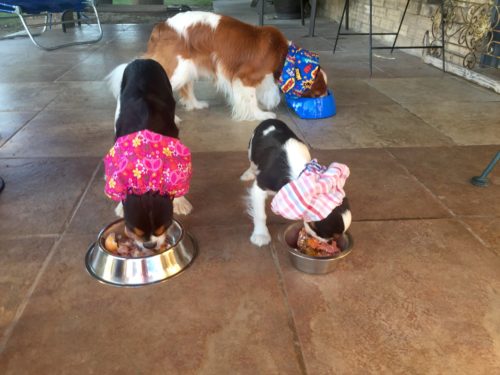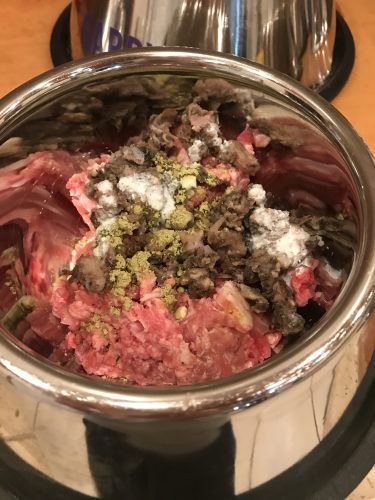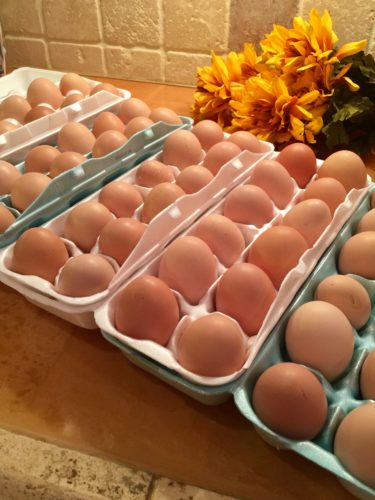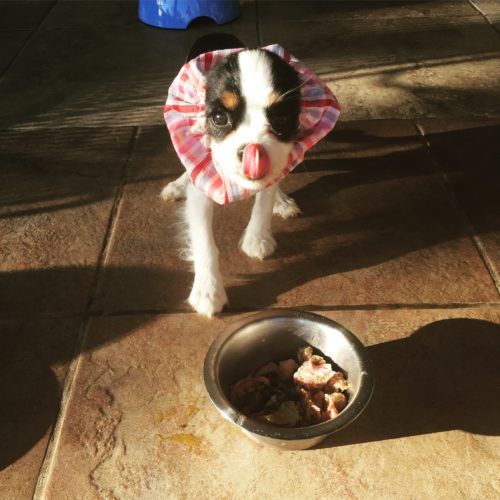The very first thing I want to say is, I am not a DVM. I am not a canine/animal nutritionist. I am not a specialist for animals in any way.
Thank you for continuing to be wiling to learn a better way to give your dog the very best food you can offer. Researching, learning and trying to give your dog the healthiest food with optimal nutrition for the longest healthiest life possible.
Now I will begin to TRY and compile some literature, links, examples, resources and photos of what exactly we feed Fourpines Cavaliers. This will be an ongoing collaboration as we continue to research and learn.
Before we go much further I’d like to point out that IF you have been feeding a manufactured kibble your dog will absolutely go through a “detox” period. His system has been so laden with chemicals, heavy metals and toxins it could take several weeks to clean all that out.

A few of our Cavaliers eating breakfast on the front patio
Ok I’ll begin by giving you a list of our favorite things
My Favorite Meaty bones (50% to 65% of the diet)
Turkey and duck necks
Chicken backs, necks, wings and legs
Veal ribs and tails
Venison bones of any kind
Muscle Meats (40% to 60% of the diet)
From a variety of animals (includes heart and tongue) These are the meats that are abundantly available to us – chicken, beef, rabbit, turkey, goat, pork and deer. We order a few other meat such as beaver, buffalo, duck and sheep from mypetcarnivore.com
Offal
(10% of the diet) -Liver, kidneys, spleen, brain, lung, other sweetbreads……Liver making up 5% of the over-all weekly offal rations.
Balanced foods (feed often)
Eggs with shell (fresh, free range, organic if possible)
Green tripe
Whole animals (rabbit, quail, etc.)
Also includes fish but this should be fed less often, due to mercury exposure

Dove frame, green tripe, ground beef, homemade kefir, pinch of kelp, cod liver oil and vit E capsules (both punctured and squeezed over top.
Extra yummies
Chicken & Turkey feet and beef windpipes (good source of naturally occurring glucosamine and chondroitin)
Beef neck bones (a great chew that won’t break teeth)
Bone broth ice cubes For the bone broth, use whole chickens, lots of joints like necks and feet, and pig bones for their chondroitin, which is very healing for the gut. Metals don’t generally store in the joints so also use a hock or stifle. Place the bones in a stockpot and cover with water; add three to four tablespoons of organic apple cider vinegar, bring to a boil and simmer for at least 24 hours. Strain the broth (throw away the bones), cool and refrigerate. Fat may harden on the top and you can remove it before feeding. Give your dog a tablespoon or two a day on their food or like we do freeze in a regular ice cube mold and feed as a treat. They love them and have no idea how incredibly nutritious they are for them.
Wild-caught fish like sardines, tuna, mackerel and salmon. Other Omega-3 oils like chia seed, flaxseed or hempseed.
Fresh Raw Veggies to also aid in cleaning teeth such as carrots and zucchini.
Coconut oil for a host of reasons. A link for more info — https://www.sitstay.com/blogs/good-dog-blog/37662913-coconut-oil-for-dogs-the-ultimate-guide or here https://wellnessmama.com/13700/benefits-coconut-oil-pets/ — I like so many things on Wellness Mamas Web-Site. Love her natural ways.
Raw milk Preferable Goat milk. It is the most bioavailable and balanced source of vitamins, minerals, trace elements, fatty acids and essentially anything else you can and can’t think of – or has yet to be determined.Because milk is food made by nature it has the enzymes and built-in mechanisms for the body to use 100 percent of the nutrients.It also contains 200 different probiotic strains that not only thrive in a food environment but are further assisted down the digestive tract by specific proteins. I consider this to be the most important food item to add to any dog’s diet. http://www.dogsnaturallymagazine.com/goat-milk-for-dogs/ or here — http://www.loyalbiscuit.com/loyal-blog/the-big-buzz-behind-raw-goat-s-milk
Sea vegetables are used as sources of calcium, iodine and trace minerals. Herbs like curcumin, ginger and cayenne are potent antioxidants, and ginger and curcumin are amazing in DNA repair. Green leafy vegetables like spinach are a must and along with broccoli, are capable of going inside cells and turning off the switched-on inflammatory pathways. Blend or lightly steam veggies to increase digestibility, then add one tablespoon to the breakfast of small dogs or 3-4 TBS for large breed dogs.
Probiotics, Prebiotic’s and all sorts of digestive health. Here’s an introduction
1. PROBIOTICS What are probiotics? They are the “good bacteria” that help improve the digestibility of ingredients and are an essential part of the immune system. By feeding your dog food with live probiotics after it has been cooked and cooled (to assure maximum survival) reinsures you are re-inoculating the digestive tract.
2. PREBIOTICS Prebiotics are similar to probiotics. However, according to the International Scientific Association for Probiotics and Prebiotics (ISAPP), “prebiotic targets the microbiota already present within the ecosystem, acting as a ‘food’ for the target microbes with beneficial consequences for host.” Basically, the prebiotic serves as the nutrition for the health and performance of the “good bacteria” in your dog’s digestive tract. Some examples of prebiotic ingredients to look for in your dog’s food include beet pulp, soybeans, raw oats and inulin.
3. NATURAL FIBER If you’ve ever had issues going to the bathroom than you probably know what fiber has to offer. Fiber promotes the digestive regularity by helping to move food waste from your dog’s digestive tract through the colon at an optimal speed. While it may not be pretty, your dog will thank you. Common sources of natural fibers in healthy dog food include flaxseed and oatmeal. You can also find some sources of fiber that can serve as prebiotics too, such as beet pulp.
4. DIGESTIVE ENZYMES Your dog breaks down the food in much the same way you do — with digestive enzymes. Produced by organs such as the pancreas, digestive enzymes break down the food so that the intestinal tract can absorb all those great nutrients, which are then distributed throughout your dog’s body. When digestive enzymes are added to dog food, it helps to increase digestibility and reduce the stress on your dog’s bodily organs.
5. PHYTONUTRIENTS Phytonutrients are found in the skins of vegetables and fruits. They act as powerful antioxidants and are known to help neutralize free radicals in order to keep the cells of the body healthy. They are few other natural dog food ingredients that enhance the immune system and help protect a dog’s body like phytonutrients.
The best thing to read prior to taking the plunge. Thank you Dogs Naturally Magazine!!
I LOVE THIS BLOG “Keep The Tail Wagging” http://keepthetailwagging.com

A few of our beautiful hens!

Thanks for the eggs girls!!

Gabby says “Lip smacking good!”
Specifically about feeding CKCS http://cavalierhealth.org/diets.htm
The Official RFC Guide to Switching to Homemade Raw
For people that truly desire to feed their pets better, more natural food, there are some wonderful “pre-made” mixes you can order and have delivered directly to your home
These guys really do have something for everyone. http://www.instinctpetfood.com/for-dogs
Informative site with great options http://www.rawpetfood.com/?gclid=CNTx79HasNICFQe5wAodzWQKEw
For the puppy families in the southern part of Texas. This is what Austin Raw Feeders Coop has to say ….. Many of our members feed a meat and bones-based raw diet based on the work of Dr. Ian Billinghurst (formerly known as Bones and Raw Food, or BARF), but several different styles of feeding are represented in our program. http://www.arfcoop.org/index.html
Honestly it is not hard at all to feed your dogs a raw diet. There is a vast array of options. From sourcing yourself to pre-made to partial raw. Just researching to inform yourself and trying something raw related is better than nothing at all. If you are feeding whole animals or a variety of raw meaty bones and organ meats, then your diet will be balanced. Raw foods contain the exact proportions of fat, protein, vitamins, minerals, and enzymes a dog needs. The only “trick” is giving them a variety of meat, bone and offal – from as big of a variety of animals as possible.
A great source of ready made raw http://www.rawpawspetfood.com

Hi Ducks – Thanks for the eggs!

